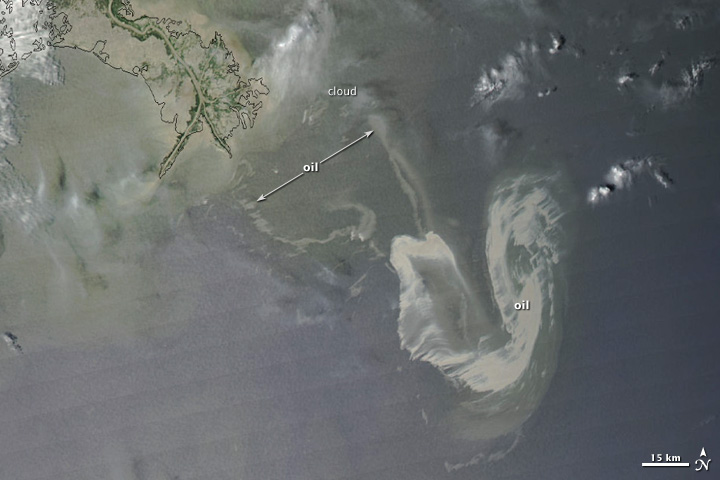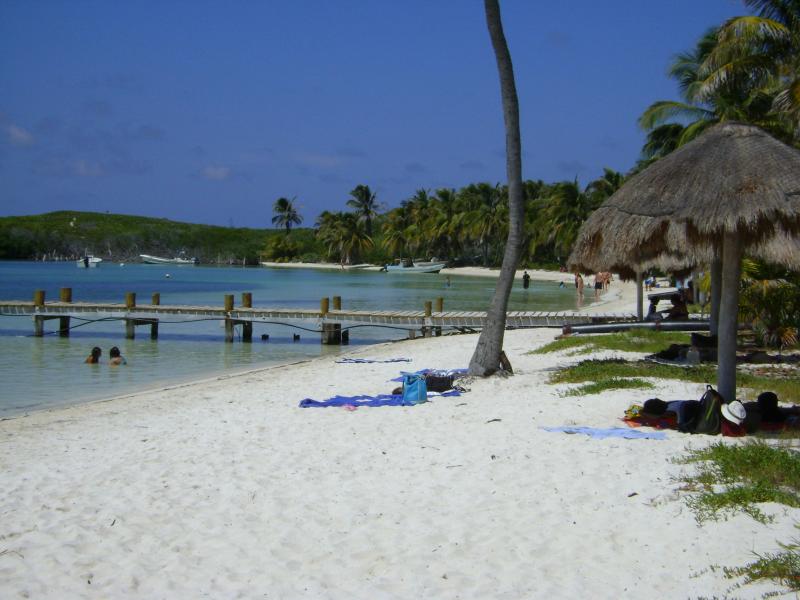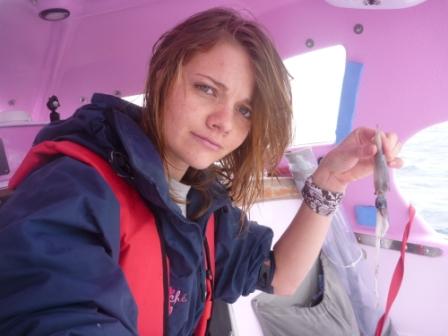A Surreal Year (but let’s race)

A NOAA view of the Gulf of Mexico on a cloudy May 10
When Guy Brierre calls 2010 “a surreal year” that means something.
I got to know this Finn (among other things) sailor in the wake of Hurricane Katrina, a time which surely qualified as surreal along the Gulf Coast—and for hundreds of miles inland—and the Gulf Coast to this day is still recovering from Hurricanes Ivan, Dennis, Katrina and Rita, and now sailors are casting a wary eye seaward or perhaps we should say, oilward, and do I hear a rousing chorus of Spill Baby Spill?
I reckon not.
Brierre is one of the sparkplugs at Southern Yacht Club, and just now he’s juggling the role of regatta chairman for Wednesday’s 26th running of Regata al Sol, 555 measured miles from Pensacola, Florida to a finish line at Isla Mujeres, a gem of an island off the eastern coast of the Yucatan. I say “juggling” because the Deepwater Horizon oil spill threatened to change this plan, big time, or even shut it down. Instead, the workaround—literally, a workaround—is looking good to succeed, meaning that Brierre gets to make his 11th Gulf crossing, this time aboard Big Booty, the first GP42 in the USA.
“Adding a waypoint 60 miles east of the rhumb line adds only 12 miles to the course,” Brierre says. “Right now it looks as if tapping 86 30W will keep us out of the oil, and I want all our competitors to know that we’re not going to send them through an oil slick.” (The offset requires boats to sail east of 86 30W from 29 15N to 28 50N.)
The undoglegged version . . .
A dogleg won’t alter strategy, on a practical basis, when it comes to navigating the currents of the Gulf Loop (a clockwise noogie in the Gulf of Mexico that is part of the Gulf Stream) or the eddying Loop Current Ring. You don’t get to Isla Mujeres without playing the which-way’s-the-water-going game. As in, you’re sailing south and parts of the race course are flowing north, west, east, south.
Two cruiser-racer divisions, with and without spinnakers, start Wednesday. Racer-racers are off on Thursday. Pensacola YC and Club de Yates Isla Mujeres are partnered with Southern YC to conduct the race, and there will be tracking at iBoattrack.com. When it looked as if the oil spill might kill the race entirely, Brierre says, “The people at iBoattrack were great. They had already shipped the transponders, and I asked, If we have to cancel, what’s my obligation. They said, ‘No obligation.’ Well, at the least we’ll cover the shipping costs. ‘Fine.’ ”
Then, last week, there was a conference call with the owners of the boats, “And they didn’t want to cancel, they wanted to race,” Brierre says. “Two years ago we had 21 boats, a low turnout, and that was Katrina-driven. What with the economy this year, I thought we were doing pretty well with 20 boats. That was including 11 newcomers and two on the rebound from the Havana Race that got cancelled. Then two dropped out. One of those took a lightning strike and $30,000 worth of damage. The other guy has beachfront property and just won’t walk away from it. I could ask, What you gonna do there, boy? But he wants to be there, and that’s the way it is.”
Two boats came all the way from Houston to race, and Big Booty came from Charleston, South Carolina. “That’s traveling 1,200 miles to sail a 555-mile race,” Brierre says. It’s a big outing for owner Pat Eudy, who’s moving into grand prix from a J/105.
Scratch boat in the fleet is the TP52, Decision, owned by Stephen Murray of New Orleans, who also owns the course record off a 59-hour passage in 2002 with his Andrews 70, likewise named Decision. The 70 was lost to Katrina, but Murray’s TP52 is capable of setting a new record if reality lives up to the forecast: Upwind work early on, with windy reaching for the last 450 miles. (Can I get a Rebel Yell on the face of that wave?)
Isla Mujeres is less than five miles long and averages only 1500 feet wide. “Two thirds of Isla Mujeres is uninhabited,” Brierre says. “It’s a neat place. Small hotels only. Friendly people. For those of us who have been there a few times it’s like a homecoming. The shopkeepers know us.”
It’s also easy-in, easy-out for families and friends, at 20 minutes by ferry from Cancun with its international airport. My advice: Hurry through Cancun.
[The Gulf Loop has loomed large in calculations of how far the Deepwater Horizon spill could spread. The strong current of the Loop would be capable of carrying oil up the east coast of Florida and beyond. On Sunday on CBS’s Face the Nation, Coast Guard Commandant Thad Allen noted that the oil presently is north of the Loop: “It does not appear to be a threat right now.”]
DEPARTMENT OF KUDOS
If you’ve been bugged the way I’ve been bugged at the way most media treat the Gulf oil spill—talking as if it doesn’t matter until the oil hits shore—you will appreciate Judy Woodruff’s PBS interview of oceanographer Sylvia Earle, whose message I would sum up as, “It’s the ocean, stupid.”
Yes, the beaches and the marshlands are critical eco-features. But, Earle says, “The real problem is the ocean itself and the life that’s out there. The dispersants they are using make the oil seem to go away, but in reality they compound the problem, breaking it up into smaller pieces and adding toxins to the living system.”
Her wake up call: Sylvia Earle
MEANWHILE I HAVE . . .
. . . friends ashore, who fish the barrier islands, and they’re watching the advance of the oil, and wondering if they’ll be fishing a month from now . . .
AND IF YOU’VE BEEN SO FORTUNATE
As to sleep through the fact that we have a long-running controversy regarding kids attempting a “youngest circumnavigator” record, which the World Speed Sailing Record Council has wisely decided it’s not going to endorse or recognize, and that we have a young woman on the brink of finishing a circumnavigation out of Sydney, Australia—she’s timing her return for Saturday, for the crowds, and you can register for tickets at jessicawatson.com.au or buy a Jessica Watson hat or a Jessica Watson wall chart—and if you’ve been so fortunate as to sleep through the fact that her publicity team will claim the “youngest” title for her 16-year-old self, and that others object because then-18-year-old Jesse Martin completed a circumnavigation in 1999 that met the distance-sailed requirements of the WSSRC (equal to the earth’s circumference at the Equator) and Jessica didn’t sail that far but why should that be relevant since the WSSRC doesn’t recognize the record anyhow, and somehow we’ve made a controversy out of what should have been an unadulterated triumph of long distance sailing by a young person whose latest blog is about repairing her Yanmar by rigging a water transfer pump in place of a failed fuel pump, and whether we approve or not of sending minors to sea (and my original intent was to ignore all of these people altogether) Jessica Watson clearly was capable of doing this thing and—
 As the British general said, surveying the field of Australian dead,
As the British general said, surveying the field of Australian dead,
Pity.
That’s Jesse Martin to the right, in an image that he posted on his web site.
Jessica will have been out 210 days when she enters Sydney Harbor on Saturday. Unassisted (except for ample advice and support over the radio and internet, as needed) and nonstop, sailing an estimated 22,808 miles. According to Jessica, Jesse Martin will be on hand to greet her. His personal web site presently leads with the cryptic message below—

Jessica writes, “If I haven’t been sailing around the world, then it beats me what I’ve been doing out here all this time.” Besides cooking up the occasional calamari . . .



